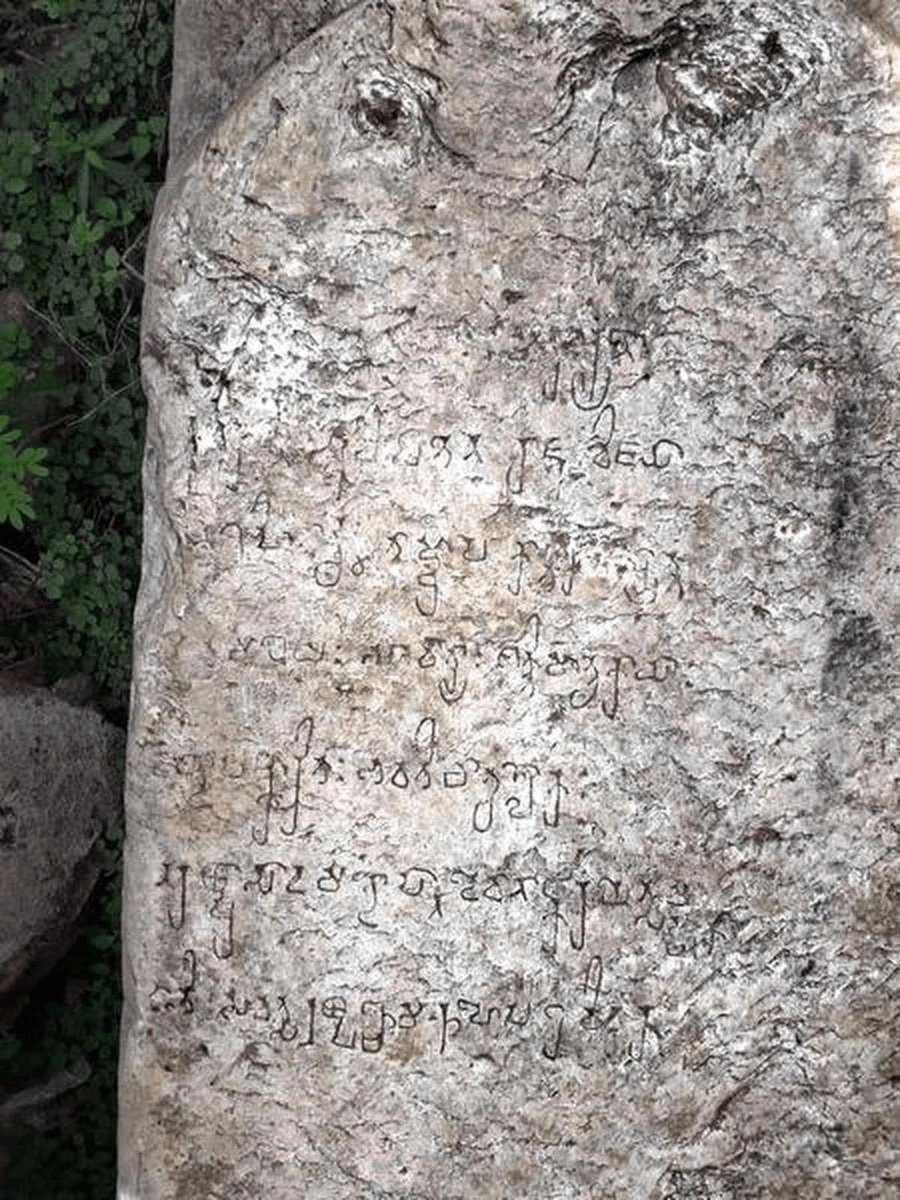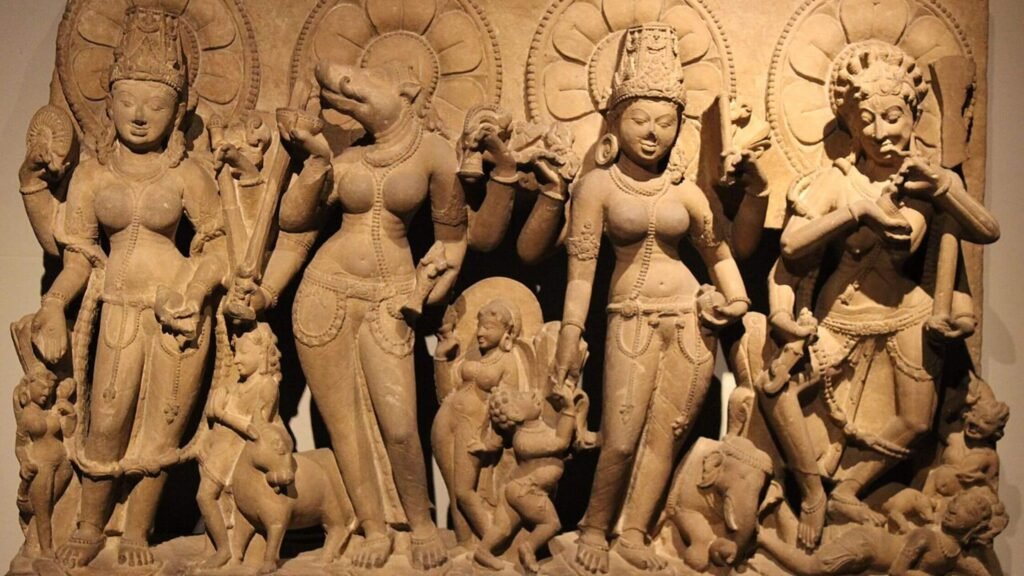சப்த மாதர் என்போர் இந்து மதத்தில் வணங்கப்படும் ஏழு பெண் தெய்வங்களின் குழுவாகும். இந்தத் தெய்வங்கள் பிரம்மா, விஷ்ணு, சிவன் போன்ற முக்கியக் கடவுள்களின் சக்திகளையும், அம்சங்களையும் வெளிப்படுத்துவதாக நம்பப்படுகிறது. இந்த அரிய கல்வெட்டு சமஸ்கிருத மொழியிலும், பிராமி எழுத்துக்களிலும் பொறிக்கப்பட்டுள்ளது. இது கி.பி. 207 ஆம் ஆண்டில் சாதவாகன மன்னர் விஜயாவின் ஆட்சிக்காலத்தில் வெளியிடப்பட்டுள்ளது.
இந்தக் கல்வெட்டு, ஆந்திரப் பிரதேசத்தின் குண்டூர் மாவட்டத்தில் உள்ள செப்ரோலு கிராமத்தில் கண்டறியப்பட்டுள்ளது. சப்தமாத்ரிகா வழிபாட்டிற்கான மிகப் பழமையான கல்வெட்டுச் சான்றை அவர்கள் கண்டறிந்துள்ளனர். மேலும், இது இன்றுவரை தென்னிந்தியாவில் கண்டுபிடிக்கப்பட்ட மிகப்பழமையான சமஸ்கிருதக் கல்வெட்டு என்பதும் இதன் சிறப்பம்சமாகும்.

செப்ரோலு கிராமத்தில் உள்ளூர் மக்கள் தங்கள் பீமேஸ்வரர் கோயிலை சீரமைக்கும் பணிகளில் ஈடுபட்டிருந்தபோது, சில வேலைப்பாடுகளுடன் கூடிய ஒரு கல் தூண் இருப்பதை கண்டறிந்து, அதனை அதிகாரிகள் கவனத்திற்கு கொண்டு வந்தனர்
இந்தக் கல்வெட்டை ஆய்வு செய்தபோது, அதில் பொறிக்கப்பட்டிருந்த தகவல்கள், “கார்த்திகா என்ற பக்தர், தம்ப்ரபே Tambrape (இது செப்ரோலுவின் பண்டைய பெயர்) என்ற இடத்தில் உள்ள பகவதி (தேவி) சக்திமாத்ருகா (சப்த மாதர்) கோயிலில், மன்னரின் நற்பெயருக்காக, ஒரு கோயில், ஒரு மண்டபம் மற்றும் தெய்வச் சிலைகளை பிரதிஷ்டை செய்துள்ளதாக கல்வெட்டு பதிவு செய்துள்ளது.
சப்த மாதர் வழிபாட்டின் குறிப்புகள் ஏற்கனவே ஆரம்பகால கடம்பர் செப்புத் தகடுகளிலும், ஆரம்பகால மற்றும் கிழக்கு சாளுக்கியர்களின் செப்புத் தகடுகளிலும் காணப்படுகின்றன. இருப்பினும், தற்போது கண்டுபிடிக்கப்பட்டுள்ள இந்தக் கல்வெட்டு, ஏற்கனவே கிடைத்திருக்கும் சான்றுகளை விட சுமார் 200 ஆண்டுகள் பழமையானது. இது சப்த மாதர் வழிபாட்டின் காலத்தை மேலும் பின்னுக்குத் தள்ளுகிறது.

இதுவரை, தென்னிந்தியாவின் பழமையான சமஸ்கிருதக் கல்வெட்டாக, இக்ஷவாகு மன்னர் எஹவல சாந்தமூலரின் 11-வது ஆட்சியாண்டில் வெளியிடப்பட்ட கி.பி. 4 ஆம் நூற்றாண்டைச் சேர்ந்த நாகார்ஜுனகொண்டா கல்வெட்டு கருதப்பட்டு வந்தது.
ஆனால், செப்ரோலு கல்வெட்டு குறித்த அனைத்து பதிவுகளையும் சரிபார்த்த பிறகு, சாதவாகன மன்னர் விஜயாவின் கி.பி. 207 ஆம் ஆண்டு செப்ரோலு கல்வெட்டுதான், தென்னிந்தியாவில் இதுவரை குறிப்பிடப்பட்ட சமஸ்கிருதக் கல்வெட்டுகளில் மிகவும் பழமையானது என்பது உறுதியாகியுள்ளது.
சாதவாகனர் காலத்தில் செழித்து வளர்ந்த தனிப்பட்ட சப்தமாதர் வழிபாடு பின்பு பரிவார தெய்வ நிலைக்கு சுருங்கியதையும் அறியமுடிகிறது.
Earliest Sanskrit Inscription and Evidence of Saptamatrika Worship Discovered in South India
In a remarkable archaeological discovery, the Epigraphy Branch of the Archaeological Survey of India (ASI) has unearthed what is now recognized as the earliest epigraphic evidence of the Saptamatrika cult. This finding is historically significant not only for its religious importance but also because it marks the earliest known Sanskrit inscription discovered in South India to date.
The term Saptamatrikas refers to a group of seven mother goddesses in Hindu tradition. These deities are revered as personifications of the divine energies (Shaktis) of major male gods such as Brahma, Vishnu, Shiva, and others. Their worship forms a vital part of early Shakta and Tantric traditions in India.
This ancient inscription, written in Sanskrit using Brahmi script, was issued by Satavahana king Vijaya in the year 207 A.D., during the 5th year of his reign. It was discovered earlier this month in Chebrolu village, located in the Guntur district of Andhra Pradesh.
According to Dr. K. Muniratnam, Director of the Epigraphy Branch at ASI, Mysuru, the discovery was made possible after local villagers reported the presence of an engraved stone pillar. The villagers encountered the pillar while repairing and restoring the Bheemeshwara temple, a local heritage structure.
Following this lead, the epigraphy team examined the engravings. Upon deciphering the inscription, they found it documents the construction of a temple (prasada), a mandapa (pavilion), and the consecration of images. These structures were established on the southern side of the temple by an individual named Kartika, who dedicated the work for the spiritual merit of King Vijaya. The temple was built in honor of Bhagavathi Saktimatruka, another name for the goddess Saptamatrika, at a place referred to as Tambrape—the ancient name for Chebrolu.
Dr. Muniratnam pointed out that although references to Saptamatrika worship are known from early Kadamba, Chalukya, and Eastern Chalukya copper plate inscriptions, this newly found inscription predates them by nearly two centuries.
Until now, the earliest datable Sanskrit inscription from South India was believed to be the Nagarjunakonda inscription issued by Ikshvaku king Ehavala Chantamula in the 4th century A.D. However, this latest discovery from Chebrolu pushes that date back to the early 3rd century A.D., significantly rewriting the epigraphic history of South India.
Dr. Muniratnam emphasized the importance of preserving and conserving such monuments. He remarked that many ancient sites across India remain unprotected and unexplored, yet they may hold invaluable insights into the region’s religious, cultural, and linguistic evolution.




